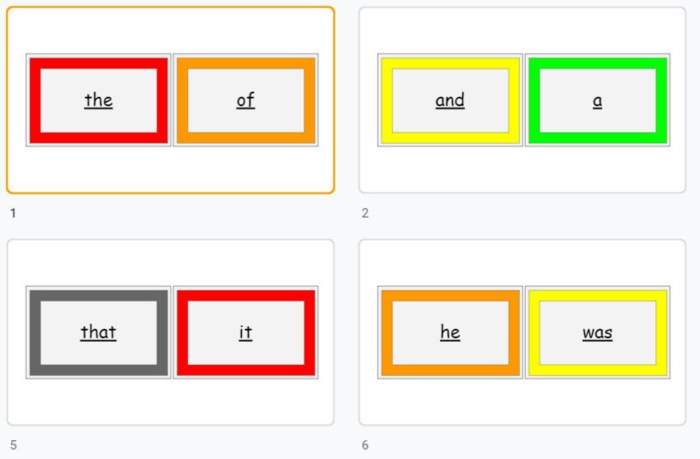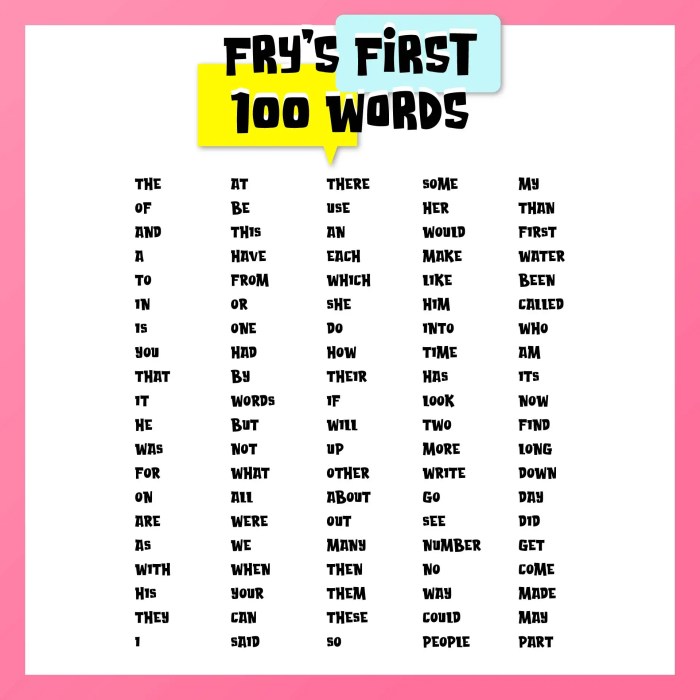Fry’s First 100 Word List stands as a cornerstone in the realm of education, serving as a beacon for early literacy. This curated compilation of words has played a pivotal role in shaping reading instruction for generations, laying the groundwork for countless individuals to embark on their literary journeys.
Delve into the captivating history, methodology, and pedagogical applications of Fry’s First 100 Word List. Explore its profound impact on reading education and discover how it continues to empower learners in the 21st century.
Historical Context of Fry’s First 100 Word List
Fry’s First 100 Word List, developed by Edward Fry in 1957, holds a significant place in the history of education. This list comprises the 100 most frequently used words in the English language, and its creation was driven by Fry’s desire to enhance reading comprehension among students.
The list’s importance stems from its ability to identify the core vocabulary essential for reading fluency. By ensuring that students master these foundational words, educators can lay the groundwork for successful reading comprehension. Over time, Fry’s list has become an indispensable tool for teachers, curriculum developers, and researchers.
Application in Reading Instruction
Fry’s First 100 Word List has played a pivotal role in shaping reading instruction practices. Educators use the list to create materials that help students develop sight word recognition and build vocabulary. By focusing on these high-frequency words, students can quickly expand their reading ability and gain confidence in their reading skills.
The list has also been instrumental in assessing students’ reading progress. By tracking students’ mastery of the 100 words, educators can identify areas where additional support is needed and tailor instruction accordingly.
Methodological Considerations

Edward Fry’s methodology for creating his list involved analyzing the frequency of words in a large corpus of written text. He selected the 100 most frequently occurring words in the English language and compiled them into his list.
Criteria for Word Selection
Fry used several criteria to select the words included in his list. These criteria included:
- Frequency of occurrence: Words were selected based on their frequency of appearance in the text corpus.
- Part of speech: Fry included a variety of parts of speech in his list, including nouns, verbs, adjectives, and adverbs.
- Level of difficulty: Fry selected words that were considered to be appropriate for the reading level of students in the early stages of literacy development.
Potential Limitations and Biases
There are some potential limitations and biases associated with Fry’s approach. These include:
- Corpus limitations: The corpus used by Fry may not have been representative of all written English text, which could have influenced the selection of words in his list.
- Frequency bias: The focus on frequency of occurrence may have resulted in the inclusion of words that are common but not necessarily essential for reading comprehension.
- Subjectivity: The criteria used for word selection were somewhat subjective, which could have introduced bias into the list.
Word Frequency and Distribution
Fry’s first 100 word list is a high-frequency word list that represents the most commonly used words in the English language. These words account for a significant portion of written and spoken English text, making them essential for early literacy development and reading comprehension.
The frequency of occurrence of words in Fry’s list varies significantly, with some words appearing much more frequently than others. The most common word in the list, “the,” accounts for approximately 7% of all words, while the least common words, such as “away,” “because,” and “little,” occur less than 0.1% of the time.
Distribution of Words Across Parts of Speech
The words in Fry’s list are distributed across different parts of speech, including nouns, verbs, adjectives, and adverbs. Nouns are the most common part of speech, accounting for approximately 40% of the list. Verbs are the second most common, making up about 30% of the list.
Adjectives and adverbs account for approximately 15% and 10% of the list, respectively.
Patterns and Trends in the Frequency of Specific Words, Fry’s first 100 word list
There are several patterns and trends in the frequency of specific words in Fry’s list. For example, function words, such as articles, prepositions, and conjunctions, tend to be more frequent than content words, such as nouns and verbs. Additionally, words that are used in a variety of contexts tend to be more frequent than words that are used in only a few specific contexts.
Pedagogical Applications

Fry’s First 100 Word List serves as a valuable tool in improving reading proficiency. Its versatility allows for seamless integration into various reading lessons, offering a structured approach to enhancing students’ sight word recognition and overall reading fluency.
Incorporating Fry’s List into Reading Lessons
- Word Recognition Games:Engage students in fun games like “I Spy” or “Bingo” using words from the list, fostering visual recognition and word recall.
- Sight Word Practice:Display the words on flashcards or a word wall for students to practice reading and writing them independently, reinforcing their familiarity.
- Guided Reading:Use the list to create leveled reading passages that gradually introduce new words, building confidence and fluency.
- Decoding Activities:Break down unfamiliar words into smaller chunks based on the list, enabling students to decode them phonetically and expand their vocabulary.
Benefits and Challenges
Benefits:
- Accelerates sight word recognition, improving reading fluency.
- Provides a structured approach to vocabulary building.
- Enhances students’ confidence in their reading abilities.
Challenges:
- May not be suitable for all learners, particularly those with dyslexia or other reading difficulties.
- Relies on rote memorization, which can be tedious for some students.
- Requires consistent practice and reinforcement to maintain retention.
Comparison to Other Word Lists
Fry’s First 100 Word List is often compared to other commonly used word lists, such as the Dolch Word List and the Oxford Wordlist. While these lists share some similarities, there are also some key differences.
Dolch Word List
The Dolch Word List is a list of 220 words that are considered to be the most common words in the English language. It was developed by Edward William Dolch in the 1930s and is widely used in schools to teach reading and spelling.
The Dolch Word List is divided into five levels, with each level containing words that are increasingly difficult to read and spell.
One of the main similarities between Fry’s First 100 Word List and the Dolch Word List is that both lists contain a high frequency of common words. However, there are also some key differences between the two lists. Fry’s list is shorter than the Dolch list, containing only 100 words compared to 220 words.
Additionally, Fry’s list includes a wider range of words, including some that are not as common as the words on the Dolch list.
Oxford Wordlist
The Oxford Wordlist is a list of 1000 words that are considered to be the most important words in the English language. It was developed by the Oxford University Press and is widely used in schools and universities to teach vocabulary.
The Oxford Wordlist is divided into 10 levels, with each level containing words that are increasingly difficult to read and spell.
One of the main differences between Fry’s First 100 Word List and the Oxford Wordlist is that the Oxford Wordlist contains a wider range of words. The Oxford Wordlist includes many words that are not as common as the words on Fry’s list.
Additionally, the Oxford Wordlist is more structured than Fry’s list, with words being divided into 10 levels.
Advantages and Disadvantages of Using Fry’s List Over Other Word Lists
There are several advantages to using Fry’s First 100 Word List over other word lists. First, Fry’s list is shorter than other lists, making it easier for students to learn. Second, Fry’s list contains a high frequency of common words, which makes it a good choice for teaching reading and spelling.
Third, Fry’s list is not as structured as other lists, which gives teachers more flexibility in how they use it.
Fry’s first 100 word list, a cornerstone of early reading instruction, includes essential words like “chair.” Delving deeper into this familiar object, one can explore parts of a chair diagram , such as the backrest, seat, and legs. Understanding these components enhances vocabulary and reinforces the concept of a chair in Fry’s word list.
However, there are also some disadvantages to using Fry’s First 100 Word List. First, Fry’s list does not contain as many words as other lists, which may limit the vocabulary of students who learn from it. Second, Fry’s list is not as structured as other lists, which may make it more difficult for teachers to use it in a systematic way.
Contemporary Relevance: Fry’s First 100 Word List
Fry’s First 100 Word List remains relevant in the 21st century, as it provides a solid foundation for early literacy development. However, it can be adapted to meet the needs of contemporary learners.
One area for adaptation is the inclusion of more diverse vocabulary. The original list primarily reflects the language of the 1950s, and some words may be unfamiliar to today’s children. Updating the list with more contemporary words would enhance its relevance.
Technology and Literacy
- Integrating technology into the learning process can make learning the Fry words more engaging and interactive. Educational apps, games, and online resources can provide a fun and effective way to practice reading and writing these words.
- Digital tools can also be used to track students’ progress and provide personalized learning experiences. By monitoring each student’s performance, teachers can identify areas where additional support is needed and tailor instruction accordingly.
Inclusion and Representation
- The Fry list can be adapted to promote inclusivity and representation. By incorporating words that reflect diverse cultures, backgrounds, and experiences, educators can create a more equitable and welcoming learning environment.
- This can be achieved by including words from different languages, representing various ethnicities and cultures, and addressing topics related to social justice and equity.
Questions and Answers
What is the significance of Fry’s First 100 Word List?
Fry’s First 100 Word List is a foundational tool in literacy education, providing a core vocabulary for early readers.
How has Fry’s list been used in reading instruction?
Fry’s list has been used to create reading materials, assess reading fluency, and identify students with reading difficulties.
What are the advantages of using Fry’s list?
Fry’s list is widely recognized, well-researched, and provides a solid foundation for building reading skills.